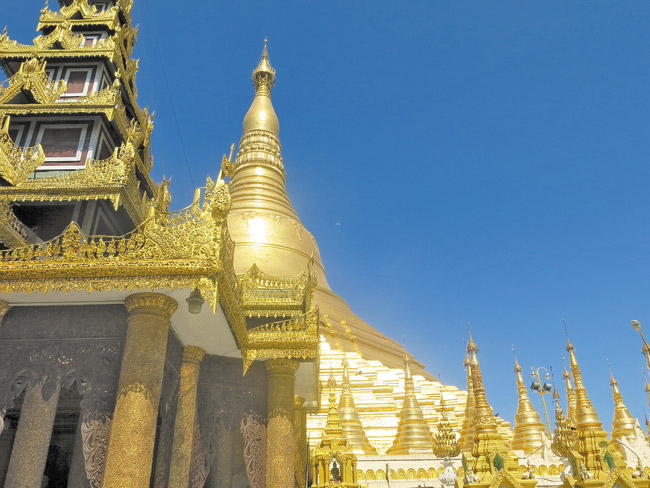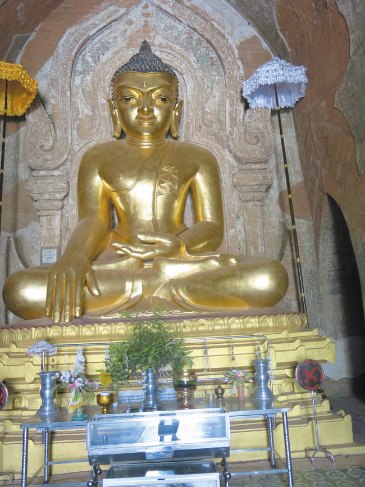Pleasant Surprises In A Myanmar Visit
As mentioned last week, it’s possible to get a boat ride on the Yangon River. Inquire at The Strand Hotel (about a 15-minute, $3 taxi ride from the Panda). Across from The Strand I enjoyed a really good lunch at the wharfside Junior Duck restaurant, including fantastic steamed whole river fish.
Not to be missed is Shwedagon Pagoda. Its earliest roots are said to date from shortly after the Buddha achieved enlightenment in 600 B.C. Over the millenia it has grown, and the grounds now comprise 120 acres and the gold-plated top rises 344 feet – something like 7 tons of gold and gold leaf were used. The top of the stupa is encrusted with 4,531 diamonds, the largest and topmost at 72 carats. Entry fee is $8, and crisp U.S. bills are preferred. Here as at other Buddhist shrines in Myanmar, no socks or shoes are allowed inside. (Tip the shoe lady before setting off to view the temple, and bring wet wipes for foot cleansing afterward.) I hired a guide for $10, and it was money well spent – otherwise it would have been one big golden blur of buddhas and stupas. If you know what day of the week you were born, visit your day’s “corner.” I’m a Sunday boy, and was instructed to dip water from a fountain and pour a small splash over the Sunday buddha’s head for each year I’ve been alive, plus one more. It took a while, and careful counting, but the guide said I am now blessed forever. Which is nice.
Following the four-day media conference, I flew 80 minutes north to Bagan in a Bagan Air turbo-prop for three days and two nights.
The Bagan plain was once the home of a wealthy culture. Between the 11th and 13th centuries, it’s said more than 10,000 Buddhist pagodas, temples and monasteries were built as kings and queens sought to “make merit.” It’s also said that over-spending on religion led to the kingdom’s decline – not enough left for self-defense and domestic issues, though it was good for the “construction industry” of the time (sound familiar?). Today, more than 2,200 of these structures remain, some small enough to fit in your driveway, others with immense footprints and rising hundreds of feet into the sky, housing amazing golden buddhas and ceiling paintings. Mr. Min-Min arranged for a driver to take me from pagoda to pagoda, for which I was grateful when I saw people riding rented bicycles for miles and miles in the dusty Southeast Asian heat. By the way, I was told that seeing Bagan from a hot-air balloon is the way to go, though I enjoyed the ground experience.
That said, I was a bit put off by vendors selling what I’d call “tourist crap” outside pagoda after pagoda – anybody want a cheap replica jersey of Brazilian soccer star Ronaldinho? On one hand, I recalled the New Testament story of Jesus “cleansing the temple” in Jerusalem of those who did business there. On the other, this is a poor country and people have to scrape out a living somehow.
The driver also took me to an open-air market where women spread produce and other wares on blankets on the ground. Stalls featured Myanmar lacquerware, jade and bronzed figures, as well as clothing. I bought a longyi, the barrel-shape cloth that is cinched at the waist and is standard waist-down wear for men in Myanmar. Haggling over prices is the norm here – never buy anything at the first price quoted.
It wasn’t exactly Augusta’s Magnolia Lane, but the approach to the Bagan Golf Club down a mile of tunnel-arched acacia trees nicely mirrored the peaked arches of the many pagodas and temples. The club’s holes wind between pagodas small and large, and I often found myself saying, “Just aim it at the stupa.” It’s not fancy, and the grass was a bit thin, but holes are interesting and greens are good. With a caddie, rental clubs and sleeve of balls, the cost for walking nine holes was about $65.
Back to the Irrawaddy, also called Ayeyarwady, where my thoughts often drift.
My first glimpse came on the first day in Bagan, during a break in pagoda visits. My driver took me through scrub brush and tall grasses on a sandy one-lane road. Coming to a blind bend, he tooted his horn as warning for potential approaching vehicles. Where the heck is he taking me? I wondered. And then we arrived at a lovely open-air riverside restaurant, the Ayeyarwady River Cafe. Over plump river shrimp in a rich, red curry, pinepple slices roasted in honey for dessert, and a couple of tall Myanmar lagers (did I mention it goes down easy?), my eyes gradually took in the river – what it is now and what it will be in the rainy season. Still of impressive width now, a half mile at least in places, the sandy flood plains on either side of the river stretch off to the horizon, a mile or more.
At the Bagan Thande Hotel – where the indoor dining room is actually a two-story cottage built for the Duke of Windsor, later King Edward VII, in 1922 – I took meals at an outdoor restaurant on a bluff above the Irrawaddy and watched all manner of commercial boats large and small motoring up and down the placid river.
The Irrawaddy begins at the confluence of the N’mai and Mali Rivers that run down from Himalayan glaciers, and then meanders 1,350 miles through Myanmar, fed along the way by countless tributaries, spreading into a massive delta region south of Yangon before flowing into the Andaman Sea. Its name is said to derive from the Sanskrit airāvatī, meaning “elephant river.” It is big, the source of life, culture and history for a country inhabited by homo sapiens for more than 10,000 years, and 700,000 years before that by homo erectus, and influenced every day by that river.
On my final afternoon in Bagan, I hiked down from the hotel and walked along the shore, skipping ancient stones of multi-hues and geologic origins. I stumbled across areas where someone – perhaps the men and women who live in a couple of small, stilted fisher huts in shallow water – had planted rows of corn and other crops in the sandy soil filled with organic goodness brought down each year in the monsoon floods.
For a couple of hours, I was a grateful part of the timeless Irrawaddy – a tiny part, but other than the river itself, tiny is the only kind of parts there are here.
Next: The man who came in from the jungle – life, death and politics in Myanmar.
dchapman@midweek.com







